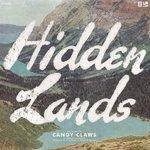
Candy Claws Hidden Lands
(twosyllable)
The descriptor “dream pop” should have been reserved for this album, as should the achingly over-employed journo fallback “ethereal”. Having first met at an Evangelical church, Candy Claws have put out an appropriately heavenly sounding sophomore offering.
A comforting blanket of ambience is pulled over the listener as the album opens. Although the sparse post-rock-esque guitar, the rustly electronics, and the diatonic chord choices make threats of an oncoming Glósóli pastiche (not to mention the reverb that drenches the lot), In The Deep Time thankfully takes less than half a minute to unveil Candy Claws' superior level of invention, with the entry of bright jumping synth gestures and whispers that recall múm at their most rested.
On The Bridge is bustling and Sufjan-esque both in its vocal style and its snowy bell-adorned arrangement. Much like with the work of Stevens, there is a prominent sense of location; during many of these tracks the mountains of Fort Collins can be instantly visualised, as carefully sculpted synth and percussion sounds meld with an innate local consciousness.
There is no shortage of addictive melodies on this album, Sunbeam Show, Miracle Spring, and Sun Arrow being the most memorable. Some moments are reminiscent of Flaming Lips' lower-key efforts, if more ghostly in their orchestration and tonal trajectories; presumably helped in no small part by the use of high-pitched synthesised strings and jazz-lent harmonic tensions.
The electronic elements of this record are tempered with such a level of restraint that the passive listener is not conscious of any processing whatsoever. Vocal, synth and guitar colours blend with electronic sounds into a cohesive hue, and - although said cohesion often comes at the price of variety - the whole record presents as a intoxicating, blindingly orchestrated, skyscape.
These ideas of blending and cohesion bring us to the outright coolest technique used on Hidden Lands. Each track actually contains a sample of every other song on the album, resulting in a haunting unity. The listening experience is one of déjà vu and micro-nostalgia: a stirring retrospect, but merely to a time one or two songs ago. Truly unusual and fascinating stuff. The nostalgic qualities do not stop there, as added-note chords recall early jazz ballads, some of the harmonic progressions hark back to Classical orchestral music, and the occasional passage recalls the milky string arrangements of 1950s film soundtracks. These myriad instances of historical influence contribute further to the heady mist of this album's sound.
One of the better albums of the year, no exaggeration.
8 August, 2010 - 19:47 — Michael Waters